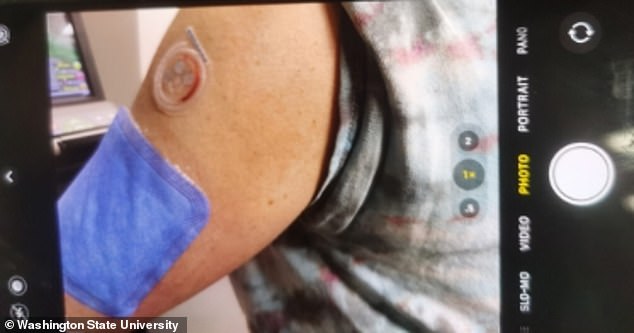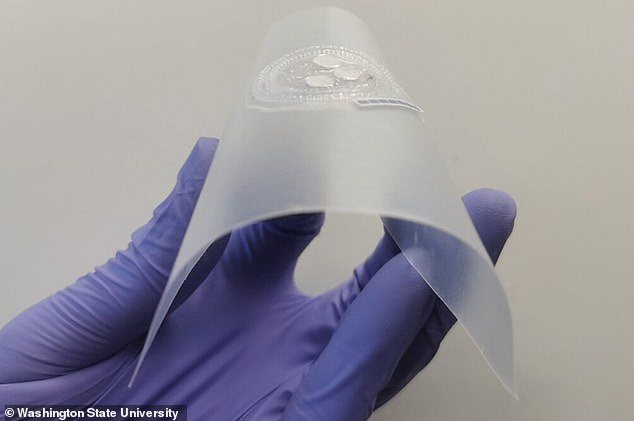Scientists print a 3D ‘sticker’ that can tell if you are at risk of diabetes by collecting your SWEAT
A simple sticker could pave the way for easier diagnoses of diabetes, heart disease and kidney failure.
Researchers from Washington developed a small adhesive health monitor that people can wear discreetly on their arms, filled with small pathways that collect and measure their sweat and the levels of three important health markers.
Human testing of the sticker-like devices has shown them to be highly accurate at measuring glucose, lactate and uric acid, which could indicate possible kidney and heart problems, as well as diabetes.
Sweat can reveal a host of health problems, but unlike blood collection, its collection is non-invasive. And the flexible health monitors are made in a 3D printer for a fast and cheap production process.
Researchers say the devices have the potential to have a huge impact on healthcare, offering a new method of detecting diseases early.
Sweat contains many important metabolites that can reveal health problems, and unlike blood samples, collecting sweat is non-invasive

The health monitor measures the sweat on a volunteer’s arm. As part of the prototype testing, shown above, the sweat was dyed red and the blue stain was used for laboratory comparison
Chuchu Chen, PhD student at Washington State University and first author of the paper, said: ‘Diabetes is a major problem worldwide.
“I think 3D printing can make a difference in healthcare, and I wanted to see if we could combine 3D printing with disease detection methods to create such a device.”
During testing, people wore the patch while exercising and it changed color to indicate the specific biochemical levels of the three markers.
It measures users’ uric acid levels, used to diagnose kidney problems, glucose levels, used in diabetes diagnoses, and lactate levels, which reflect exercise intensity and indicate when a person reaches their maximum threshold, a key indicator of personal fitness.
When the researchers compared the results from the monitors on volunteers’ arms with traditional laboratory results, they found that the monitors accurately and reliably measured the concentration of the chemicals and the rate of sweating.
Researchers wrote in their report, published in the journal ACS sensorsthe study successfully “demonstrated the functionality and reliability of our health monitor, which generated reliable… results of sweat rate, glucose, lactate and uric acid concentrations during physical exercise.”

The small device is manufactured using a 3D printer. It now measures three biomarkers, but can be scaled up relatively easily to test more
The monitor’s channels are printed on the devices using a technique called direct inkwriting, which creates self-supporting structures that capture human sweat.
The structures collect sweat on the sticker, which is infused with bioassays that measure the presence and amount of a certain health marker, such as uric acid.
The sticker provides real-time analysis and produces a color change indicating the levels of each biomarker.
The patches are still in the pilot phase for validation and have not yet been released to the market. But given the pace at which new technology is arriving in healthcare, especially driven by the advent of AI, this may not last long, according to a WSU news release.
People with diabetes can already use sticker-like devices to track their blood glucose levels over time, but that requires a small sensor that goes under the skin, making it somewhat invasive.
However, the sweat sensor does not require any incision.
Early detection of diseases, especially chronic diseases such as heart disease and cancer, is crucial to treat them effectively and maximize life expectancy.
Several such technologies are already available.
a quick and painless electrocardiogramwhich requires a doctor to stick small electrodes to a patient’s chest, arms and legs to record the heart’s electrical activity from different angles.
And to detect cancer, especially lung, breast, colorectal, blood, prostate and ovarian cancer, doctors can use this a non-invasive liquid biopsythat analyzes body fluids such as blood, urine or saliva.
Traditional biopsies require doctors to take tissue samples from the body.
And a simple urine test can help doctors detect elevated creatinine levels in people at risk for kidney disease and assess kidney function, potentially mitigating a late-stage diagnosis with little chance of survival.
